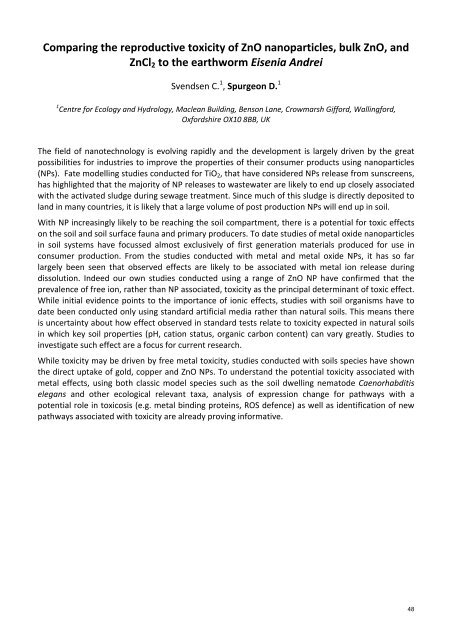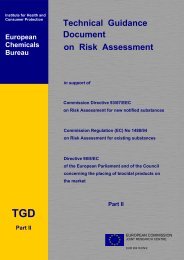Challenges of Regulation and Risk Assessment of Nanomaterials
Challenges of Regulation and Risk Assessment of Nanomaterials
Challenges of Regulation and Risk Assessment of Nanomaterials
Create successful ePaper yourself
Turn your PDF publications into a flip-book with our unique Google optimized e-Paper software.
Comparing the reproductive toxicity <strong>of</strong> ZnO nanoparticles, bulk ZnO, <strong>and</strong><br />
ZnCl2 to the earthworm Eisenia Andrei<br />
Svendsen C. 1 , Spurgeon D. 1<br />
1 Centre for Ecology <strong>and</strong> Hydrology, Maclean Building, Benson Lane, Crowmarsh Gifford, Wallingford,<br />
Oxfordshire OX10 8BB, UK<br />
The field <strong>of</strong> nanotechnology is evolving rapidly <strong>and</strong> the development is largely driven by the great<br />
possibilities for industries to improve the properties <strong>of</strong> their consumer products using nanoparticles<br />
(NPs). Fate modelling studies conducted for TiO2, that have considered NPs release from sunscreens,<br />
has highlighted that the majority <strong>of</strong> NP releases to wastewater are likely to end up closely associated<br />
with the activated sludge during sewage treatment. Since much <strong>of</strong> this sludge is directly deposited to<br />
l<strong>and</strong> in many countries, it is likely that a large volume <strong>of</strong> post production NPs will end up in soil.<br />
With NP increasingly likely to be reaching the soil compartment, there is a potential for toxic effects<br />
on the soil <strong>and</strong> soil surface fauna <strong>and</strong> primary producers. To date studies <strong>of</strong> metal oxide nanoparticles<br />
in soil systems have focussed almost exclusively <strong>of</strong> first generation materials produced for use in<br />
consumer production. From the studies conducted with metal <strong>and</strong> metal oxide NPs, it has so far<br />
largely been seen that observed effects are likely to be associated with metal ion release during<br />
dissolution. Indeed our own studies conducted using a range <strong>of</strong> ZnO NP have confirmed that the<br />
prevalence <strong>of</strong> free ion, rather than NP associated, toxicity as the principal determinant <strong>of</strong> toxic effect.<br />
While initial evidence points to the importance <strong>of</strong> ionic effects, studies with soil organisms have to<br />
date been conducted only using st<strong>and</strong>ard artificial media rather than natural soils. This means there<br />
is uncertainty about how effect observed in st<strong>and</strong>ard tests relate to toxicity expected in natural soils<br />
in which key soil properties (pH, cation status, organic carbon content) can vary greatly. Studies to<br />
investigate such effect are a focus for current research.<br />
While toxicity may be driven by free metal toxicity, studies conducted with soils species have shown<br />
the direct uptake <strong>of</strong> gold, copper <strong>and</strong> ZnO NPs. To underst<strong>and</strong> the potential toxicity associated with<br />
metal effects, using both classic model species such as the soil dwelling nematode Caenorhabditis<br />
elegans <strong>and</strong> other ecological relevant taxa, analysis <strong>of</strong> expression change for pathways with a<br />
potential role in toxicosis (e.g. metal binding proteins, ROS defence) as well as identification <strong>of</strong> new<br />
pathways associated with toxicity are already proving informative.<br />
48








